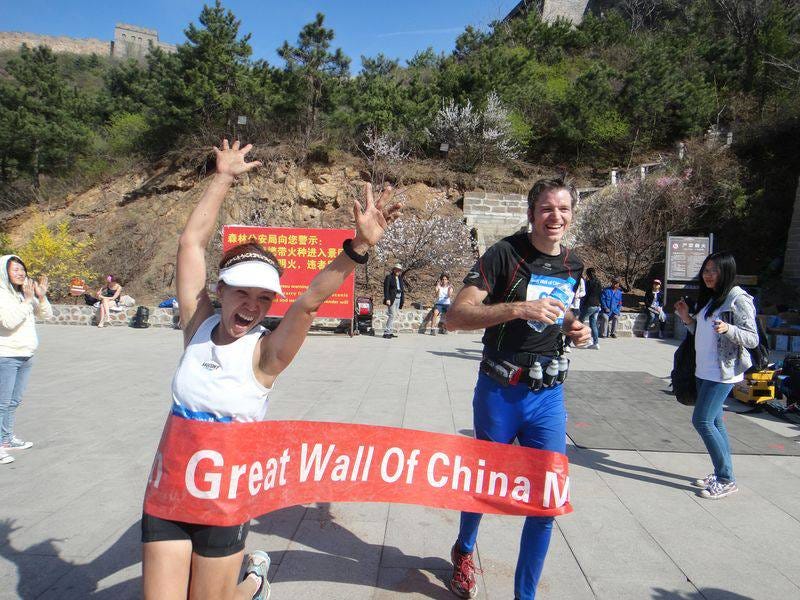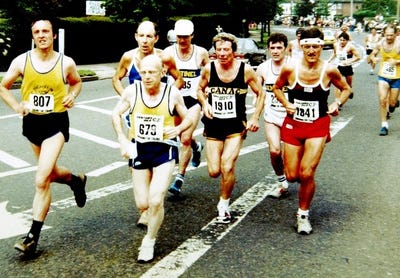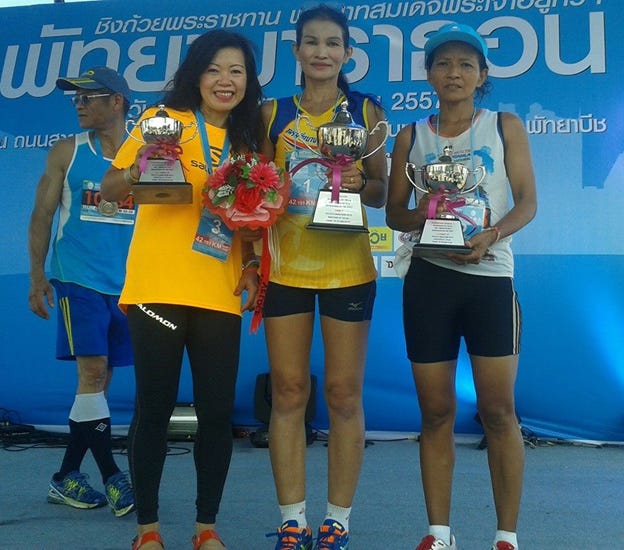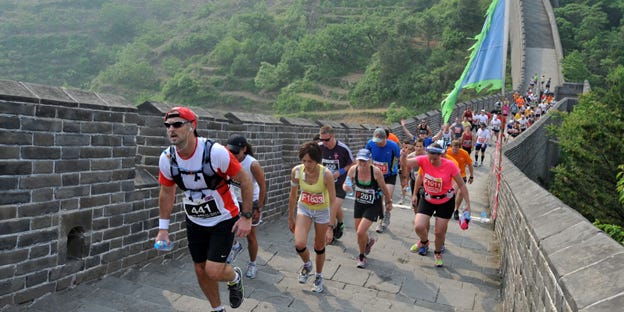The Over 50s Running Revolution in Asia
Running is very much the domain of the over 50er in Asia.
One of my writing collaborations with Maggie Kim Hong Goh
The running revolution came to the 'Western World' during the 1980s when the great mass marathons like London, New York, Boston, Chicago, Melbourne, and the like, exponentially increased in participant numbers during that decade. Many had in excess of Ten Thousand participants, which have grown to over Forty Thousand in some cases today.
However according to race statistics, running in the big city marathons in the 'Western World' is very much an under 50 phenomenon where on average around 25% are under 30 years of age, 30% under 40, with another 30% under, leaving less than 15% in the over 50s categories. For example, those over 50s running in the Gold Coast Airport Marathon in Queensland, Australia and the Chicago Marathon this year barely made up 15% of the participants.
However, this is not the case in many parts of Asia today. In contrast to the mass marathons of the 'Western World', the Bangkok Marathon for example, had less than 10% of the participants under 30 years of age, with the bulk of the field (60%+) in the 30-49 age category.
What is very interesting is that a good 30% of participants were over 50 years old. This is reflected in marathons across the Asian region, showing a big difference in runner demographics between "East and West".
Although, outright crowds may be smaller in the mass marathons within the Asian region, they are certainly growing year by year.
The Over 50 Phenomenon
Running is very much the domain of the over 50er in Asia.
Perhaps this can be explained as one 40 something runner told the authors in Thailand, that the under 30s have career and family in mind, and thus no time for other pursuits that do not bring in an income or career boost.
In Asia today, people retire much earlier than those in the 'Western World' (retirement ages are much lower). 50 something's have ample time with good health for the pursuit of some of the challenges they never an opportunity to tackle in their youth. They belonged to the generation that had to study and work towards financial and career goals due the heavy responsibilities towards their families in the early years of life.
But retirement brings a need for a new beginning, where many feel they still need to excel at something, rather than just idly sitting by 'waiting to die' as the stereotype once went.
In many situations, running may begin as a means to reduce weight, and/or stay healthy. But once an over 50er has participated in one of the many 'fun runs', mini marathons, and marathons, the pass-time often very quickly becomes addictive. For many, running provides over 50ers with the opportunity to build new social networks pursuing the same interests, daily activities which cuts out the notion of boredom in retirement, and the opportunity to travel and sight see both domestically and internationally.
The over 50ers in Asia are the baby-boomers who only recently due to relative economic prosperity vis a vis their 'Western' counterparts have the opportunity available to pursue their non-monetary passions in life. They were busy in the 1980s developing their careers in developing countries which often faced issues of survival, rather than leisure.
Retirement has offered many the opportunity to have the athletic career that they never had the chance to have. And because of this, "50 in Asia is becoming the new 20s", as many retire to take up marathon running as a post career vocation.
So why the marathon?
It's a challenge. It's the Mount Everest of athletics. It's a challenge to human endurance. It's something to achieve and be proud of. It can be done.
Secondarily, marathon running is the path to many friendships and travel to places for a good reason. In many retirees’ mind, travel to Melbourne to run the Melbourne Marathon is much more an important reason to go, than seeing Koalas, Kangaroos, and Penguins. Trips to Melbourne, London, Boston, and Chicago become missions. They are dreams that can be achieved. Just look at how many participants in the major city marathons in the world are foreign visitors from the Asian region. Each year the Gold Coast Airport marathon organizers have a special enclosure for the Japanese participants in the marathon start and finish complex.
Among the over 50ers, there are different types of runners. Firstly, there are those who run for a reason like staying healthy and losing weight, etc. Then there is the social group. A small group of runners see themselves as being highly competitive and run for times and places. Then there are the running tourists who travel from place to place to run a marathon. Then there is the semi-serious, still pursuing a career runner, who would like to do better.
However, 'being competitive' is also being redefined by the over 50s, where running is not so much about bettering times, but rather competing in, and completing, as many runs as possible over the year.
The over 50ers demographic is powerful in numbers and spending power, but has often been forgotten by race promoters and running magazines who focus too much on the younger elite runners. Prizes reflect this and most often the age categories get very little in the way of prizes.
Sponsorship is also scarce in the age categories, where sporting goods manufacturers don see the value in supporting over 50er role models in the marathon scene.
This should be set to change in the not too distant future, as the race promoters are beginning to recognize who their clients are.
Finally, this over 50 phenomenon is changing the rules of running. Marathons were once seen as something reserved for the elite, where no one would contemplate running more than two or three marathons a year. Now we have people running them almost every week.
So, the first rule is that there are very few barriers as to what should be run. Twenty marathons a year is common place, with many taking up the challenges of say the high-altitude Mount Bromo marathon in Indonesia or the The Great Wall Marathon in China. They are extreme challenges which just don't stop at the marathon distance, as ultras are very quickly increasing in popularity as well.
Asia has become the centre of the world for the senior runner.
Originally published on OVI Magazine 1st November 2014
You can subscribe for free emails of future articles here:
Maggie Kim Hong Goh is a runner, come Audax cyclists, who is always looking for that new challenge. Maggie was the first Malaysian to complete the 6-World Marathon Majors, Great Wall Marathon ambassador 2013-15, among many others. Maggie is currently preparing for the London-Edinburgh-London Audax 1500 in 2022. Maggie has run a 3.26 marathon in her former home of Auckland, in 2005. She conducts the occasional training/motivational sessions in and around Kuala Lumpur.








